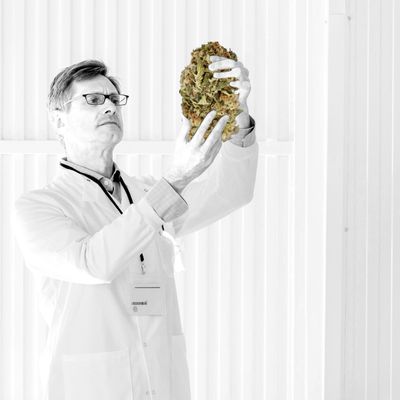
Psychedelic drugs can sound suspiciously like miracle drugs: Research suggests that some can lift depression overnight, others may treat both post traumatic stress disorder and the terror many dying people feel, and, increasingly, a number of different drugs in the class that includes acid (LSD), magic mushrooms (psilocybin), and ecstasy (MDMA) appear to have potential as life-changing addiction treatments. A less intense psychedelic, marijuana, includes compounds that show promise for pain, multiple sclerosis, cancer, and even schizophrenia.
Unfortunately, all these different potential treatments have one thing in common: Thanks to draconian Drug Enforcement Administration regulations, they are extremely difficult to study. Even at a time when Americans are becoming more and more tolerant of various substances, the government is lagging several steps behind. As a result, many people are suffering needlessly, cut off from treatments that, if allowed into the standard FDA-approval pipeline, could greatly improve their lives and save society money currently being spent on less effective treatments — or on crime and other fallout effects of untreated mental illness.
A report (PDF) last month from the Drug Policy Alliance and the Multidisciplinary Association for Psychedelic Studies highlights the great lengths the government is going to in order to get between you and your doctor. It showed that the Drug Enforcement Administration (DEA) has for decades obstructed the efforts of scientists seeking to unlock the therapeutic potential of these drugs.
The investigation found that the DEA perennially delays decisions on “scheduling” drugs like MDMA and marijuana that would increase scientific and medical access — while speeding regulations that ban them or increase restrictions. The agency is also typically quick to declare, often in contradiction to existing data, that psychoactive drugs have no medical use.
For example, the agency took 16 years to respond to a request to reschedule marijuana out of the “no medical use” classification, known as Schedule I, the first time it was asked. It dallied five years the second time and nine the third — each time rejecting the change, even as the evidence favoring it continued to grow. It overruled its own judge to classify MDMA as a “Schedule I” substance in 1986, a tactic it has also used in other cases in which it received marijuana decisions with which it disagreed. But while it takes its sweet time when pressed to overturn bans, the DEA often outlaws new substances in a matter of weeks.
And this is in marked contrast to the way the U.S. acts when its intelligence and military agencies determine such testing would be useful. In 1957, for example, the CIA secretly dosed a deputy U.S. Marshal with acid, rendering the man so disconnected from reality that he took out his gun and tried to rob a bar in an attempt to commit “suicide by cop.” Up until 1965, the agency had a San Francisco outpost in which government-hired prostitutes lured johns to a “safe house” where they would be surreptitiously dosed and then monitored by government agents. Hundreds of people were drugged without their consent.
Given that these experiments took place with substances that the same government soon declared to be too dangerous even for controlled medical use, the ongoing hypocrisy is breath-taking.
Now, however, the great wall of propaganda and fear-mongering may be starting to crumble. The L.A. Times recently reported on how, for the first time ever, the DEA is not receiving uncritical, lap-dog-like responses from Congress — but is instead being harshly attacked and even ridiculed for claiming that marijuana is as dangerous as heroin.
Researchers, too, are beginning to sense a more open climate. But fear certainly remains. “When I brought up the idea to my postdoctoral mentor, he nearly laughed me out of the office and said I’d have to do it on my own own,” says Peter Hendricks, assistant professor of health behavior at the University of Alabama at Birmingham School of Public Health, who nonetheless became the lead author on a recent study finding links between psychedelic drug use and reduced recidivism among people who had been convicted of various drug-related felonies.
One reason he was able to conduct the study was that it didn’t involve actually treating people with psychedelics, which involves jumping through numerous bureaucratic hoops in order to obtain permission both to proceed and to access the drugs. Instead, Hendricks and his team analyzed data that had already been collected from nearly 26,000 arrestees who had been diverted to a program of supervision to manage substance problems between 2002 and 2007. They found that having a history of psychedelic drug use was linked with a 40 percent reduction in recidivism, even after controlling for factors like education and employment that might otherwise explain such a connection. In contrast, unsurprisingly, a history of cocaine use doubled the odds of being sent to prison.
“When you control for all of these potential confounding variables and try to isolate the unique effects of hallucinogen use, it appears protective,” says Hendricks. His study is far from the first to suggest that psychedelics could fight addiction. For example, a recent review of research conducted in the 1960s that investigated using LSD to fight alcoholism found that the psychedelic doubled the odds of recovery — and studies are now being carried out to determine whether psilocybin can aid smoking cessation.
There’s a lot we don’t know about the potential psychological benefits (and, of course, dangers) of illegal and semi-legal drugs. But until we create a rational system for regulating these substances — one that is based on science, rather than laws created as a result of fears about race and immigration — we could be missing out on treatments for everything from Alzheimer’s to Autism.




